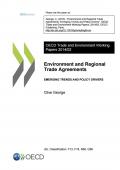
This report examines trends in the use of environmental provisions in Regional Trade Agreements and identifies factors which may explain the presence or absence of these provisions. The report builds on work of the OECD Joint Working Party on Trade and Environment (JWPTE) and includes results of an informal survey of delegates.
Analysis of the environmental provisions in RTAs reveals an encouraging upward trend. While basic provisions remain the most common types found in RTAs, the incidence of more substantive provisions has increased significantly in recent years. Among these, environmental co-operation has been the most common type.
Several factors may have contributed to this evolution. These include countries extending their political mandates for RTAs, for example to include provisions for compliance with multilateral environmental agreements (MEAs), as well as a general accumulation of experience with the use of environmental provisions.
The report includes case studies from Australia, Canada, Chile, the European Union, Japan, New Zealand, United States and Switzerland.
This report highlights the major forces fostering the shift to a resource-efficient green economy in Europe, including the role of EU policies. Currently, the economic and technological changes leading towards green economy objectives across the EU economy are proceeding too slowly; what is required is a much bigger, deeper, and more permanent change in the EU economy and society to create both new opportunities and substitution processes across the economic structure.
The ongoing review of the UK’s Fourth Carbon Budget is closely linked to the debate over the impact that domestic climate change policies can have on the competitiveness of businesses. Notably, there are concerns that, if the UK implements more ambitious climate policies than its trading partners, carbon-intensive producers might relocate. This could mean that some affected sectors may have to reduce their production of goods and services below the optimum level that would be achieved if there were uniform international climate policies. In addition, the impact of climate change policies on emissions reductions could be limited if big emitters simply relocate, especially if they move to jurisdictions that have lower environmental standards.
This study analyses trends and opportunities for trade among developing countries (i.e. South-South trade) in selected environmental goods, in order to assess the contribution such trade can make to a green economy transition. The term ‘developing countries’ includes all countries and territories listed as developing economies in the UNCTAD Handbook of Statistics (UNCTAD, 2012). The study focuses on South-South trade flows in several RE products and their components, including solar photovoltaic (PV) cells and modules, wind turbines, hydroelectric turbines, biomass feedstock, solar water heaters and solar lighting equipment, as well as other select environmental goods. The latter include water filtering and purification equipment and environmentally preferable products, such as organic agricultural goods.
How can trade policy respond to the needs and concerns of more than a billion people in the developing world that lack access to energy for fulfilling their daily needs such as cooking and lighting? An effective way would be address trade barriers to sustainable energy goods that are critical to providing such access. This paper looks at specific examples of sustainable energy goods-namely, solar technologies and associated products that have become an increasingly popular and cost-effective choice to deliver electricity to people not connected to the grid. However barriers to more widespread diffusion of these products still remain. The paper examines a number of domestic policy and market bottlenecks that stifle growth and the rate of uptake for solar products and how they can be overcome. It then examines patterns of trade in products such as solar lanterns and solar panels, policies that hinder trade such as import tariffs and taxation and a range of trade-relevant issues including, among others, those related to customs classification practices and delays in customs clearance and standardization.
